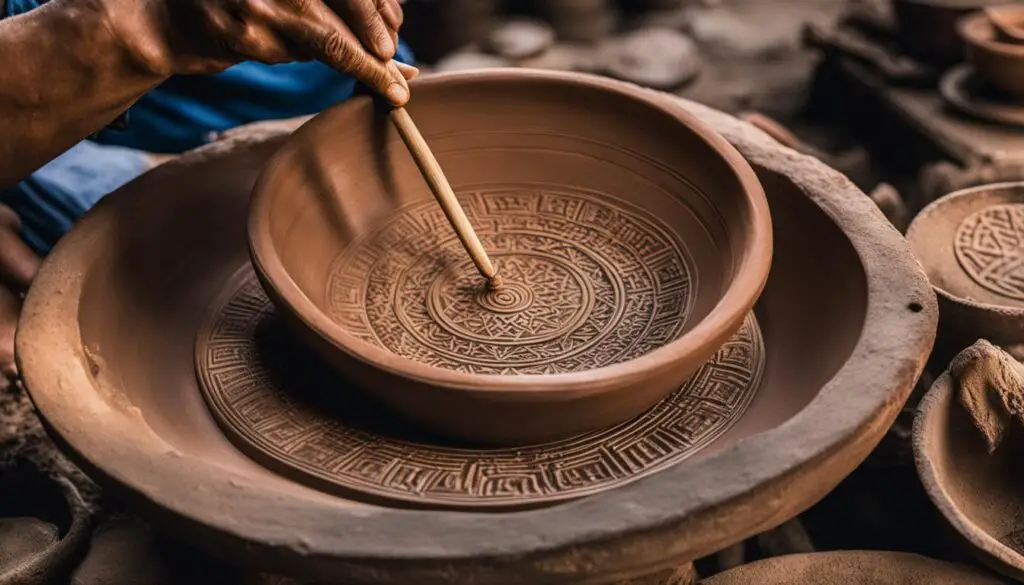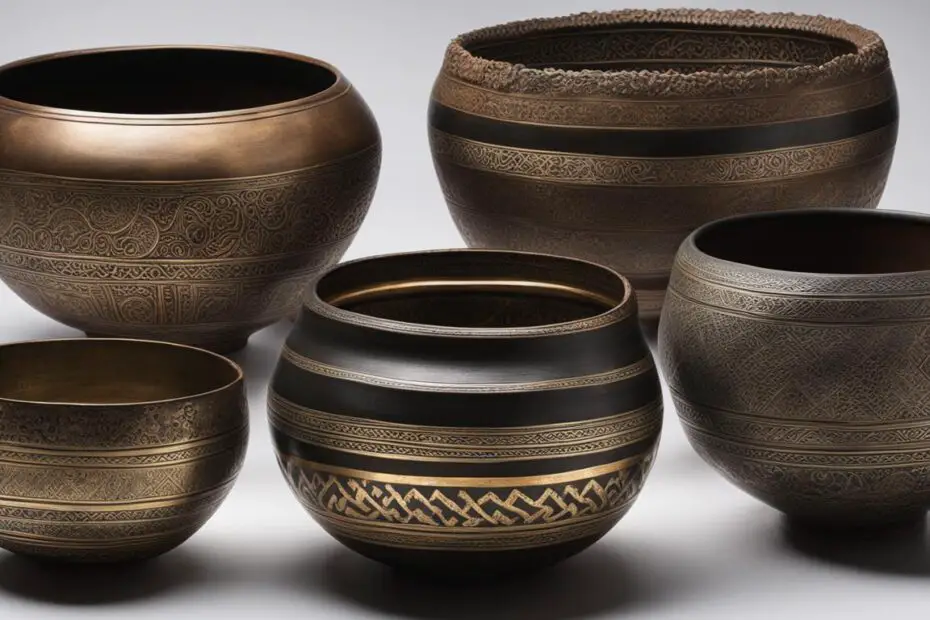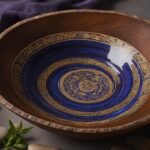Welcome to our in-depth exploration of the history and significance of prayer bowls. In this article, we will delve into the origins of these ancient artifacts, their cultural evolution, and the spiritual significance they hold for many people. Whether you are a curious enthusiast or a seasoned practitioner, join us as we uncover the mysteries surrounding prayer bowls.
Key Takeaways:
- Prayer bowls, also known as Tibetan singing bowls, have a complex and debated history.
- They gained popularity in the early 1990s, coinciding with an increased interest in Tibet.
- While their true origins remain uncertain, they have become integral to mindfulness practices, yoga studios, and sound therapy.
- Prayer bowls hold deep spiritual significance and are considered sacred religious vessels.
- The craftsmanship involved in creating these bowls is highly skilled and has been passed down through generations.
The Spiritual Significance of Prayer Bowls
Prayer bowls hold deep spiritual significance for many people, serving as both tools and symbols in religious and spiritual practices. These traditional prayer bowls, also known as Tibetan singing bowls, have a rich historical context and cultural evolution that adds to their significance as spiritual artifacts and religious vessels. Spiritually, these bowls are believed to have the power to invoke meditation, relaxation, and healing through the sound they produce when struck or rubbed on the rim. This unique sound creates a sense of harmony and peace, and it is believed to have the ability to align chakras and balance energy.
Sound therapy is another powerful application of prayer bowls. These bowls are considered effective tools for restoring harmony to the body, mind, and soul. The vibrations created by the bowls are believed to have healing properties, and they are used to promote deep relaxation, reduce stress, and improve overall well-being. The use of prayer bowls for sound therapy has gained popularity in recent years, with many individuals and practitioners incorporating them into their healing practices.
From a cultural perspective, prayer bowls have been used in various religious and spiritual traditions for centuries. They symbolize the connection between the physical and spiritual realms, and they are regarded as sacred objects of reverence. While the true origins of prayer bowls remain a subject of debate and speculation, their historical significance and cultural value cannot be denied. The craftsmanship involved in their creation is considered an art form, often passed down through generations, ensuring the preservation of traditional techniques and methods.
Unearthing the Origins of Prayer Bowls
The true origins of prayer bowls have remained a subject of debate and speculation. While they are often associated with Tibet, there is no concrete evidence to support their Tibetan origins. The production of sound bowls is not limited to Nepal, as they can be found in various locations in South and Southeast Asia, as well as in the Americas and Europe.
Some claim that prayer bowls date back to the time of Shakyamuni Buddha, while others believe they were part of an oral tradition that became exposed after the Chinese invasion of Tibet in the 1950s. However, the earliest mention of prayer bowls in written records can be traced back to the 1970s, with the release of the album Tibetan Bells by American musicians Nancy Hennings and Henry Wolff. It is believed that the popularity of the album, along with the increased interest in Tibet, contributed to the mystique and material value of prayer bowls.
To further explore the origins of prayer bowls, it is necessary to consider their historical context and cultural evolution. These bowls have transcended geographical boundaries and have been adopted by various traditions and cultures. Their wide distribution suggests a more nuanced history that goes beyond a single origin story. By delving into the historical and cultural contexts of the regions where prayer bowls are found, we may gain a deeper understanding of their origins and significance.
Table: Comparison of Prayer Bowl Origins and Features
| Region | Earliest Mention | Material Composition | Historical Context |
|---|---|---|---|
| Tibet | Uncertain | Varies | Associated with Buddhist practices |
| Nepal | 1970s | Various metals, primarily copper | Influenced by Tibetan and Hindu traditions |
| South and Southeast Asia | Varies | Varies | Embedded in diverse religious and cultural practices |
| Americas and Europe | Varies | Varies | Adopted in New Age and spiritual movements |
While the exact origins of prayer bowls may remain elusive, their presence throughout history and across different regions point to their enduring significance as cultural artifacts. Their ancient roots or the lack thereof do not diminish their value or the spiritual experiences they evoke. Instead, their undefined origins offer an invitation for further exploration and reflection on the interconnectedness of diverse spiritual practices.
Understanding the Making of Prayer Bowls
Prayer bowls have a rich history and have evolved over time in terms of their materials and craftsmanship. Ancient prayer bowls were made of pure copper, while later versions were crafted from brass, which is a combination of various earth metals including copper. Today, prayer bowls are created using up to 12 different types of metals, with copper being the primary material due to its pure sound. Different metals produce different tones, stimulating various chakras.
The process of making prayer bowls is a highly skilled craft that has been passed down through generations. Artisans in various regions still use traditional methods to create these sacred objects. The bowls are often inscribed with images of the Buddha and/or Tibetan script, making them valuable items that hold cultural and historical significance. The craftsmanship involved in their creation ensures that each prayer bowl is a unique work of art.
As prayer bowls continue to be used and appreciated in spiritual practices, their production remains an important cultural tradition. The artistry and attention to detail that go into making these bowls contribute to their value and authenticity. Whether ancient or traditional, each prayer bowl is a testament to the skill and dedication of the artisans who create them.

Table: Materials Used in Prayer Bowl Making
| Material | Tone Produced | Chakra Stimulated |
|---|---|---|
| Copper | Deep and resonant | Root chakra |
| Brass | Warm and rich | Sacral chakra |
| Silver | Pure and high-pitched | Third eye chakra |
| Gold | Clear and bright | Crown chakra |
The table above showcases some of the different materials used in prayer bowl making and the tones they produce. Each material has its unique characteristics and contributes to the overall experience of using a prayer bowl in spiritual practices.
Conclusion
Prayer bowls, also known as Tibetan singing bowls, have a fascinating history and significance in spiritual practices. While their origins remain a subject of debate, they have become widely popular in North America and Europe.
Prayer bowls hold deep spiritual significance, serving as tools for meditation, relaxation, and sound therapy. The soothing sounds produced by striking or rubbing the rim of the bowl create a sense of harmony and peace, aiding in the alignment of chakras and the balancing of energy.
These ancient prayer bowls are considered sacred religious vessels, symbolizing the connection between the physical and spiritual realms. They have been used in various religious and cultural traditions for centuries, adding to their significance as spiritual artifacts. Despite the mysteries surrounding their origins, the craftsmanship involved in making prayer bowls is an art form that has been passed down through generations, preserving their cultural and historical context.
FAQ
What are prayer bowls?
Prayer bowls, also known as Tibetan singing bowls, are ancient instruments that are commonly used in religious and spiritual settings for meditation, relaxation, and sound therapy.
Where do prayer bowls come from?
The origins of prayer bowls are still debated, but they are often associated with Tibet. However, there is no concrete evidence to support their Tibetan origins. Prayer bowls can be found in various locations in South and Southeast Asia, as well as in the Americas and Europe.
What is the significance of prayer bowls?
Prayer bowls hold deep spiritual significance, serving as tools for meditation, relaxation, and sound therapy. They are also considered sacred religious vessels and are part of the cultural and historical context of various traditions.
How are prayer bowls made?
Prayer bowls are made using up to 12 different types of metals, with copper being the primary material. Different metals produce different tones, stimulating different chakras. The craftsmanship involved in creating these bowls is highly skilled, and traditional methods are still used by artisans in various regions.
What is the historical context of prayer bowls?
The true origins of prayer bowls are still a subject of debate and speculation. While they are often associated with Tibet, there is no concrete evidence to support their Tibetan origins. The earliest mention of prayer bowls in written records can be traced back to the 1970s when they were mentioned in an album by American musicians Nancy Hennings and Henry Wolff.









